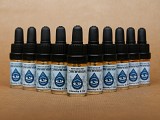Katukina, Root Bark, Cut & Sifted, 4 Gr from Brazil (SKU 4847)
Very potent Sananga rootbark, cut and sifted. This type of Sananga is locally recognised by its small leaves. Sourced from the Katukina tribe. Suitable for making your own Sananga drops. 4 gram of this material makes 50 ml Sananga. For making Sananga drops very easily we offer a Sananga DIY Kit that contains all the neccesary tools to extract the rootbark into a clean liquid. See main description for further details about the methods of extracting.
Packed in 10 ml clear plastic bottles containing 4 gram.
| change currency | ||||||||||
| SKU | Variety | Part | Form | Weight | Unit | Price | Qty
|
|||
|---|---|---|---|---|---|---|---|---|---|---|
| 4847 | Katukina | root bark | cut & sifted | 4 gr | 1 pc | $ 10.08 | ||||
| 5442 | Katukina | root bark | cut & sifted | 8 gr | 1 pc | $ 18.89 | ||||
| 5450 | Katukina | root bark | cut & sifted | 20 gr | 1 pc | $ 44.08 | ||||
Raw Sananga rootbark (Tabernaemontana undulata), Our contacts in Acre have found some very good quality Sananga. Offered in bottles of 4, 8 and 20 gram. Depending how thorough you extract the material, this little quantity of 4 gram of Sananga rootbark makes approximately 50 ml Sananga drops. All you need is water.
For inquiries about larger quantities of Sananga rootbark, contact us.
To make the process of extracting the material very easy, we offer a Sananga DIY Kit that contains all the neccesary tools to extract the rootbark into a clear liquid. The kit comes with photo-illustrated and detailed instructions that make it very easy to make and store your own Sananga.
When making Sananga drops, the part that is not easy, is filtering the liquid. For this reason we have cut and sifted our Sananga rootbark into grains that contains no powder or fine particles. This surely makes the final filtering process much easier and more effective. More tips and tricks can be learned from the photo-illustrated instructions that come with the kit.
The full description and instructions how to to make Sananga drops will be emailed to you once we have shipped your order.
Sananga is an eye drop preparation made from a potent rootbark and bark of the Tabernaemontana undulata shrub, a "Milkwood" species in the family Apocynaceae. This sacred bark is used for spiritual and mentally ailments, by clearing the mind of distractive energies and allowing for a complete new way of perceiving and focusing. It is also used by the indigenous people of the Amazon to sharpen the senses before hunting.
The pure spirit of Sananga supports a deep cleansing of blocked energies on emotional, physical, and spiritual levels. Sananga can balance and increase your energies, and find the roots of your blockages, leading to a complete equilibrium, focus and peace of mind. Moreover, its use will expand your spiritual vision and awareness, and enhance your ability to read others people´s intentions. Also, Sananga increases your long-range vision, which is important for visualizations and predictions of the future. Apart of this, the drops are also used traditionally to cure and improve a broad range of ocular problems (Lambert et al 2010), like myopia, depth and color perception, definition of images, and detection accuracy.
Short Tips & Hints
When you are new to Sananga, start with the less strong one. However it is still pretty painful. You can do it any time of day but some people have red eyes for a few hours up to a day or some cleansing process started that can take a day. So a weekend day would suit best for beginners. Your intention is important but for the first session the intention is to get to know Sananga and to channel your energies.
How to do it: Another person applies 1 drop on each eye while you lie on your back, flat. With eyes closed. The drops must go first on each eye in the inner corner. So that when opening both eyes the drops fall into your eyes. (You can not drop it yourself because when the first drop enters, you wont be capable of applying the second drop). Immediately the initial cringe will be intense. Then sit up straight and look down to the earth and breathe. Open your eyes. Channel your suffering into strength. Ground yourself. It will pass.
For detailed information about Sananga click here.
Another good article on Sananga: Scientific Studies Hint at How Sananga Eye Drops Treat Ocular Diseases
Other names: Becchete, Sananga, Tabernaemontana undulata rootbark
Sananga is produced from the roots and bark of Tabernaemontana undulata (Vahl), a member of the Apocynaceae family. T.undulata is found in Brazil, Colombia, Costa Rica, Ecuador, Guyana, Guyana Francesa, Panamá, Perú, Surinam, Trinidad y Tobago, Venezuela (Smithsonian Tropical Research Institute).
Tabernaemonta L. is one of the largest genera in subfamily Rauvolfioideae, with about 110 species distributed throughout the tropics. In Brazil, there are 30 recognized species of the genus, of which 9 are endemic (1). Most species of Tabernaemontana are trees or treelets at the forest understory, with a few species growing as shrubs or trees in open formations such as savannahs and rocky outcrops. The most diagnostic features of the genus are the tubular, whitish flowers with the lobes inflexed in bud, and follicular fruits with the seeds partially or entirely surrounded by a yellowish to reddish aril. (2)
The Kaxinawa tribe of Acre Brazil use a similar species in the same genus - T.sanaho (Ruiz & Paz) to make their Sananga. It is not well understood if other species have or are used and whether the same distinctions made by botanists are observed by native peoples.
Synonyms & common names
There has been much taxonomical confusion over this species and other genera in Apocynaceae with the following species now considered synonymous with T.undulata:
Anacampta albescens (Rusby) Mrkgr; Anartia meyeri (G. Don) Miers; Bonafousia obliqua Miers; Bonafousia perrottetii (A. DC.) Miers; Bonafousia undulata (Vahl) A. DC. ; Bonafousia undulata var. ovalifolia Miers; Echites brasiliensis Thunb. ; Peschiera surinamensis Miq. ; Stemmadenia nervosa Standl. & L.O. Williams; Tabernaemontana albescens Rusby ; Tabernaemontana meyeri G. Don ; Tabernaemontana meyeri G. Don ; Tabernaemontana perrottetii A. DC.(tropicos.org)
Sananga is also know as ‘Bechette (pronounced B’-chew-teh) by the Mati & Matses. The Kaxinawa call it ‘Mana heins’(T.sanaho)
Alkaloid content: Quebrachidine, Voaphylline, Coronaridine, (-)-19-epi-Heyneanine, Voacangine, Unknown base (M+ 382) (Van Beek et al, 1984)
Although Sananga is said to contain Ibogaine alkaloids there is actually little evidence to suggest this is in fact true. Tabernaemontanta is not actually a genus but a "sub-family", and therefore also classified as "Tabernaemontanoidae". McKenna reports that only some of the several dozen or so plants in this sub family contain ibogaine, others like ‘undulata' may only have analgesic or sedative properties.
(1)Koch. I et al 2015
(2)Marinho et al 2016
This item is not allowed in the following countries:
Belarus, Georgia, Taiwan
This natural product is offered for its ethnographic and historical value and is delivered with no expressed or implied fitness for a specific purpose. It is simply a raw botanical specimen, or a scientific sample. The information provided is purely meant for historical, scientific and educational purposes and should never be interpreted as a recommendation for a specific use. The use and application of our product is at the customer's decision, responsibility and risk.
Read our Terms & Conditions for more details.


